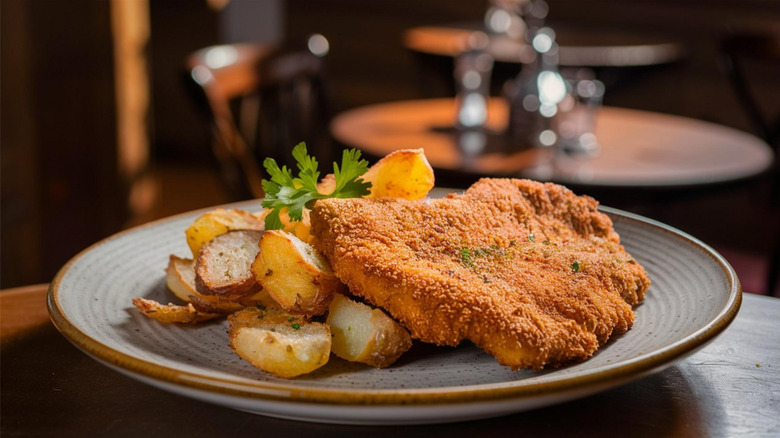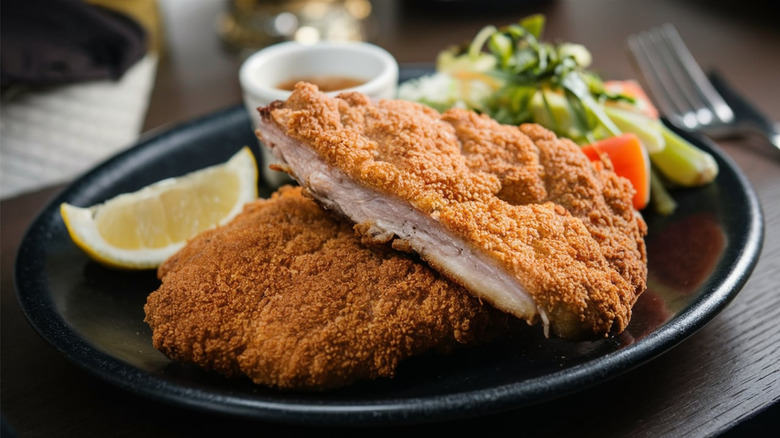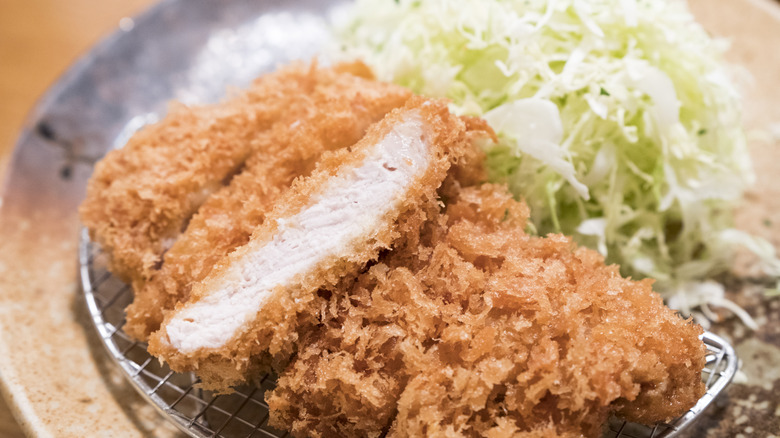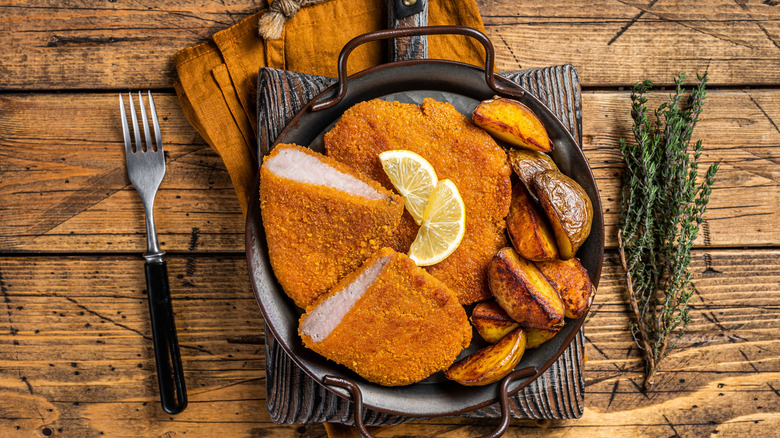Pork Schnitzel Vs Katsu: What's The Difference?
Breaded meats offer a mouthwatering quality. Start with a tender cutlet, bind with delicious crunchy breadcrumbs, and fry to a golden brown completion: it's a foolproof formula. No surprise the preparation method is found globally, involving a range of proteins. And a particularly popular meat option is pork, which shines delightful flavor and texture to the technique.
Renditions with such a protein take on many forms, whether it's delectably dense kotlet schabowy in Poland, or fermented rice paste covered Hong Zao Zha Zhu Pai in China. Two regional recipes that have attained an especially popular status are pork schnitzel and katsu. Although visually similar, there's lots of contrast between the styles. The former hails from Germany and Austria, while the latter from Japan, and accordingly, the local cuisines strongly influence the preparation. The dishes differentiate in the way the pork's cut, breaded, fried, as well as the specific accompaniments. So, while are both golden brown, crispy, and with a mouthwatering pork interior, there are quite a few details to keep in mind.
What is pork schnitzel?
Schnitzel is a beloved style of breaded and fried cutlets. The dish has appeared in Europe under many forms, with some even claiming its origins trace to Roman times. Although the exact history is unclear, its strongest ties lie with Germany and Austria, where it's famously prepared with veal and pork. The dish is defined by the pounding of meat into a very thin texture, before covering with breadcrumbs, and pan-frying into a golden, crispy form.
Pork schnitzel isn't a rigidly defined dish, and involves many cuts and styles. Pork chops are a common choice in Germany, but tenderloin appears in recipes, too. The specific type of bread isn't fixed; it's whatever dried version appears on hand. Eggs and flours are typically used as a binder, and the cutlet is pan-fried in oil and butter to an airy consistency. A bright spritz of lemon is a classic accompaniment, as is a cream sauce, and a hearty potato salad.
So, with such a malleable nature, the dish has gone on to influence further versions, like a chicken fried steak differentiated from schnitzel in the U.S. by way of German immigrants. In a similar vein, a French take on the schnitzel inspired Japan's tonkatsu in the 19th century, blending European and Asian influences into a wholly new creation.
What is katsu?
Analogous to schnitzel, katsu in Japan refers to breaded and fried cutlets of different meat types, including chicken, ground beef, and ham. However, it's the rendition with pork that's most common, first popularized by a Tokyo restaurant at the turn of the 20th century. When prepared with such a protein, the dish is called tonkatsu, not to be confused with torikatsu or tonkotsu.
Several factors contribute to katsu's unique quality. The pork's cut into thicker slices, and delineated into different grades. There's leaner and more delicate tenderloin-based hire-katsu as well as richer rosu-katsu, which comes from pork loin. This meat is then subsequently covered in crispier panko breadcrumbs, and deep fried to a delectably crunchy state.
Traditionally, katsu is accompanied with a sauce of the same name, crafted with a savory-sweet mixture of ketchup, Worcestershire sauce, oyster sauce, and sugar. The cutlet is then served in several forms, whether it's as part meal set alongside shredded cabbage, rice, and miso soup, covered in curry, or as a filling in a sandwich. Enjoyed in specialized eateries that run the gamut of casual to formal, katsu's a modern staple of Japanese cuisine.
The two dishes employ distinct ingredients and techniques
With over a century of tradition on different continents, it's no surprise the two dishes have developed local flourishes. The Japanese version comes thicker, with a more meaty consistency, as opposed to the pounded pork used in the schnitzel. Katsu's deep-frying preparation makes it easier to cook the larger pork slices all the way through, although schnitzel turns more light and airy on the pan. The distinct texture of panko breadcrumbs creates a flakier exterior, as opposed to the more breaded consistency of schnitzel.
Today, many cooks choose to meld both styles during pork cutlet preparation. Many reach for panko breadcrumbs for a lighter, crunchier breading, but prepare on a pan for an airier, fuss-free rendition. When tonkatsu sauce isn't available, another ketchup-based savory dipping sauce is swapped in. And the practice of serving tonkatsu with pickles is continued with regional flavors, perhaps brightening the cutlet with quick pickled onions and serving alongside a globally inspired potato salad. Such culinary intersections highlight the dish's wide-spanning nature: There's magic to the crispy pork delight.



